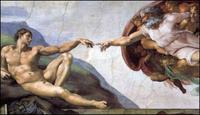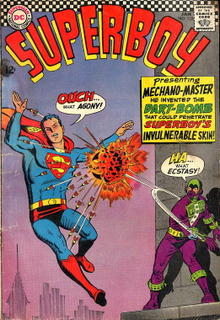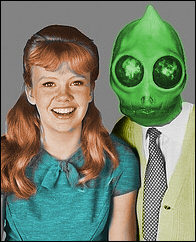Throughout the Silver Age a theme that ran in most DC comics was the "Super-hero as Messiah" parallel. Alan Moore explored this in most of what he wrote for the company. His descriptions of how normal people viewed Superman and others as a pantheon of modern gods are memorable. The Silver Age never came right out and said it but they alluded to it for the perceptive reader to catch. I really couldn't assert that it was on purpose or not but biblical and religious themes abounded. I doubt it was accidental, though. Comic books have a history of exploring and illuminating many subjects not normally questioned.
The EC comics of the 50's routinely addressed racism, religion and social issues much more starkly than any 60's or 70's mainstream comic I have ever seen. Comics of the 60's were figuratively bloodless and portrayed an Ozzie and Harriet idealized dreamworld. But this was the marketing reality of comic books still reeling from the backlash of 50's censorship.
These images from the Sistine Chapel (v2, 1512) and Superboy #135 (v1, 1967) are similar in layout, but are quite the opposite in their content.

There is an interesting inversion of the two images. In the work by Michelangelo, a deity is magically creating life, represented by the mythological Adam.
In the Superboy cover drawn by Curt Swan it is mankind, represented by the Mechano-Master, that is returning the gift of creation by using science to kill God.
That is uber-neat. Very subtle, those DC guys. Did anyone other than adults get the references? It is unlikely the art and word balloons on the Superboy cover in just that specific layout had not been intentional on the part of the creative team. I doubt coincidence was involved and the art may have been a deliberate commentary or satire.
Nearly a year earlier Time Magazine published the famous "Is God Dead?" story and I'm sure the effects of that controversy were still rippling through the American consciousness and the minds of creators of popular media. While the Nietzsche phrase "Gott is tot" (God is dead) is often quoted it is also almost always misunderstood or misapplied. Nietzsche meant it a little more subtly than how it is usually distilled for the low comprehension and short attention span of the average public. Nietzsche meant that God has less relevance in life than in times past. The idea goes far deeper than that of course than I will cover here. Popularly the phrase is usually misrepresented either as a statement that the physical creature of God is deceased or in ways that cleverly, albeit simplistically, show an assault on the body of God. Much as in the Superboy cover art.
Time Magazine, April 1966
I won't say who the Mechano-Master is, but long-time readers will be familiar with the armor's color scheme and the enmity to the Superman Family. That Man vs. God sub-plot still exists today in the Superman titles and is sometimes worth picking up for a read.
Tags: Art Swipe
Saturday, September 03, 2005
Michelangelo vs. Curt Swan
Posted by
Sleestak
at
9/03/2005 06:30:00 AM
![]()
![]()
Subscribe to:
Post Comments (Atom)



























There's no doubt there were messiah themes in the DC books, particularly with Superman. "Must There Be a Superman" confronted it head on.
ReplyDeleteBut the Michelangelo comparison is a bit much. The bent knee is a staple Superman pose, which Wayne Boring used frequently (examples).
Uhm...You *did* look at the comparisons between art, right?
ReplyDelete